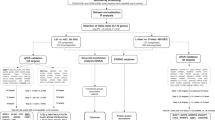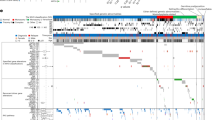Abstract
Conventional cytogenetic analysis currently stratifies acute myelogenous leukaemia (AML) into prognostically relevant groups. However, approximately 50% of adult AMLs have normal cytogenetics (NC-AMLs), and represent a heterogeneous and poorly understood group. We analysed gene expression in 55 AML samples including 53 cases from adult patients with NC-AML (n=36), trisomy 8, t(15;17), t(8;21), t(11;19), 7q deletion, and two cell lines using 9000-gene DNA microarrays. Global hierarchical clustering showed that NC-AMLs are a heterogeneous group. Supervised analysis distinguished two subgroups of NC-AML: one subgroup constituted a homogeneous NC cluster (‘pure NC-AML’), and the other NC-AMLs were close to the AML cases with translocations (‘translocation like’). Gene expression signatures were also derived for patients with trisomy 8, as well as FLT3 and MLL gene duplications. Importantly, samples from 24 NC-AML patients who could be evaluated for clinical outcome were analysed. In all, 43 genes that discriminated two classes of patients with significantly different prognosis were identified. The poor prognosis class contained a majority of ‘pure NC-AMLs’, whereas the ‘translocation-like’ AMLs were in the good prognosis class. Discriminator genes included genes involved in drug resistance (TOP2B), protein transport (MTX2, SLC35A2), and cell signalling (MAPK1, PRKAB2). Our results demonstrate the transcriptional heterogeneity of NC-AMLs, and suggest the existence of ‘translocation-like’ NC-AMLs and of a gene expression signature that may predict response to chemotherapy.
This is a preview of subscription content, access via your institution
Access options
Subscribe to this journal
Receive 50 print issues and online access
$259.00 per year
only $5.18 per issue
Buy this article
- Purchase on Springer Link
- Instant access to full article PDF
Prices may be subject to local taxes which are calculated during checkout




Similar content being viewed by others
References
Alizadeh AA, Eisen MB, Davis RE, Ma C, Lossos IS, Rosenwald A, Boldrick JC, Sabet H, Tran T, Yu X, Powell JI, Yang L, Marti GE, Moore T, Hudson Jr J, Lu L, Lewis DB, Tibshirani R, Sherlock G, Chan WC, Greiner TC, Weisenburger DD, Armitage JO, Warnke R, Levy R, Wilson W, Grever M, Byrd J, Botstein D, Brown PO and Staudt LM . (2000). Nature, 403, 503–511.
Bachrati CZ and Hickson ID . (2003). Biochem. J., 374, 577–606.
Bertucci F, Houlgatte R, Benziane A, Granjeaud S, Adelaide J, Tagett R, Loriod B, Jacquemier J, Viens P, Jordan B, Birnbaum D and Nguyen C . (2000). Hum. Mol. Genet., 9, 2981–2991.
Bertucci F, Houlgatte R, Nguyen C, Viens P, Jordan BR and Birnbaum D . (2001). Lancet Oncol., 2, 674–682.
Bertucci F, Nasser V, Granjeaud S, Eisinger F, Adelaide J, Tagett R, Loriod B, Giaconia A, Benziane A, Devilard E, Jacquemier J, Viens P, Nguyen C, Birnbaum D and Houlgatte R . (2002). Hum. Mol. Genet., 11, 863–872.
Bonilla E and del Mazo J . (2003). Biochem. Pharmacol., 65, 1701–1707.
Bullinger L, Dohner K, Bair E, Frohling S, Schlenk RF, Tibshirani R, Dohner H and Pollack JR . (2004). N. Engl. J. Med., 350, 1605–1616.
Debernardi S, Lillington DM, Chaplin T, Tomlinson S, Amess J, Rohatiner A, Lister TA and Young BD . (2003). Genes Chromosomes Cancer, 37, 149–158.
Dingemans AM, Witlox MA, Stallaert RA, van der Valk P, Postmus PE and Giaccone G . (1999). Clin. Cancer Res., 5, 2048–2058.
Downing JR and Shannon KM . (2002). Cancer Cell, 2, 437–445.
Goasguen JE, Matsuo T, Cox C and Bennett JM . (1992). Leukemia, 6, 520–525.
Golub TR, Slonim DK, Tamayo P, Huard C, Gaasenbeek M, Mesirov JP, Coller H, Loh ML, Downing JR, Caligiuri MA, Bloomfield CD and Lander ES . (1999). Science, 286, 531–537.
Grimwade D, Walker H, Oliver F, Wheatley K, Harrison C, Harrison G, Rees J, Hann I, Stevens R, Burnett A and Goldstone A . (1998). Blood, 92, 2322–2333.
Haferlach T, Kohlmann A, Kern W, Hiddemann W, Schnittger S and Schoch C . (2003a). Semin. Hematol., 40, 281–295.
Haferlach T, Schoch C, Loffler H, Gassmann W, Kern W, Schnittger S, Fonatsch C, Ludwig WD, Wuchter C, Schlegelberger B, Staib P, Reichle A, Kubica U, Eimermacher H, Balleisen L, Gruneisen A, Haase D, Aul C, Karow J, Lengfelder E, Wormann B, Heinecke A, Sauerland MC, Buchner T and Hiddemann W . (2003b). J. Clin. Oncol., 21, 256–265.
Iyer L, King CD, Whitington PF, Green MD, Roy SK, Tephly TR, Coffman BL and Ratain MJ . (1998). J. Clin. Invest., 101, 847–854.
Jaffrey SR and Snyder SH . (1996). Science, 274, 774–777.
Kato K, Ogura T, Kishimoto A, Minegishi Y, Nakajima N, Miyazaki M and Esumi H . (2002). Oncogene, 21, 6082–6090.
Kaufmann SH, Gore SD, Miller CB, Jones RJ, Zwelling LA, Schneider E, Burke PJ and Karp JE . (1998). Leukemia Lymphoma, 29, 217–237.
Kohlmann A, Schoch C, Schnittger S, Dugas M, Hiddemann W, Kern W and Haferlach T . (2003). Genes Chromosomes Cancer, 37, 396–405.
Kottaridis PD, Gale RE, Frew ME, Harrison G, Langabeer SE, Belton AA, Walker H, Wheatley K, Bowen DT, Burnett AK, Goldstone AH and Linch DC . (2001). Blood, 98, 1752–1759.
Lanotte M, Martin-Thouvenin V, Najman S, Balerini P, Valensi F and Berger R . (1991). Blood, 77, 1080–1086.
Marcucci G, Caligiuri MA and Bloomfield CD . (2000). Cancer Invest., 18, 768–780.
Noguera NI, Breccia M, Divona M, Diverio D, Costa V, De Santis S, Avvisati G, Pinazzi MB, Petti MC, Mandelli F and Lo Coco F . (2002). Leukemia, 16, 2185–2189.
Okutsu J, Tsunoda T, Kaneta Y, Katagiri T, Kitahara O, Zembutsu H, Yanagawa R, Miyawaki S, Kuriyama K, Kubota N, Kimura Y, Kubo K, Yagasaki F, Higa T, Taguchi H, Tobita T, Akiyama H, Takeshita A, Wang YH, Motoji T, Ohno R and Nakamura Y . (2002). Mol. Cancer Ther., 1, 1035–1042.
Pinto A, Zagonel V and Ferrara F . (2001). Crit. Rev. Oncol./Hematol., 39, 275–287.
Poirel H, Rack K, Delabesse E, Radford-Weiss I, Troussard X, Debert C, Leboeuf D, Bastard C, Picard F, Veil-Buzyn A, Flandrin G, Bernard O and Macintyre E . (1996). Blood, 87, 2496–2505.
Reid HM and Kinsella BT . (2003). J. Biol. Chem., 278, 51190–51202.
Reiffers J, Huguet F, Stoppa AM, Molina L, Marit G, Attal M, Gastaut JA, Michallet M, Lepeu G, Broustet A, Pris J, Maraninchi D, Hollard D, Faberes C, Mercier M, Hurteloup P, Danel P, Tellier Z and Berthaud P . (1996a). Leukemia, 10, 389–395.
Reiffers J, Stoppa AM, Attal M, Michallet M, Marit G, Blaise D, Huguet F, Corront B, Cony-Makhoul P, Gastaut JA, Laurent G, Molina L, Broustet A, Maraninchi D, Pris J, Hollard D and Faberes C . (1996b). Leukemia, 10, 1874–1882.
Sabatti C, Karsten SL and Geschwind DH . (2002). Math. Biosci., 176, 17–34.
Schoch C, Kohlmann A, Schnittger S, Brors B, Dugas M, Mergenthaler S, Kern W, Hiddemann W, Eils R and Haferlach T . (2002). Proc. Natl. Acad. Sci. USA, 99, 10008–10013.
Tanaka K, Roberts MH, Yamamoto N, Sugiura H, Uehara M, Mao XQ, Shirakawa T and Hopkin JM . (2002). Biochem. Biophys. Res. Commun., 292, 776–780.
Theillet C, Adelaide J, Louason G, Bonnet-Dorion F, Jacquemier J, Adnane J, Longy M, Katsaros D, Sismondi P, Gaudray P and Birnbaum D . (1993). Genes Chromosomes Cancer, 7, 219–226.
Valk PJ, Verhaak RG, Beijen MA, Erpelinck CA, van Waalwijk van Doorn-Khosrovani SB, Boer JM, Beverloo HB, Moorhouse MJ, van der Spek PJ, Lowenberg B and Delwel R . (2004). N. Engl. J. Med., 350, 1617–1628.
Virtaneva K, Wright FA, Tanner SM, Yuan B, Lemon WJ, Caligiuri MA, Bloomfield CD, de La Chapelle A and Krahe R . (2001). Proc. Natl. Acad. Sci. USA, 98, 1124–1129.
Wallqvist A, Rabow AA, Shoemaker RH, Sausville EA and Covell DG . (2003). Bioinformatics, 19, 2212–2224.
Yagi T, Morimoto A, Eguchi M, Hibi S, Sako M, Ishii E, Mizutani S, Imashuku S, Ohki M and Ichikawa H . (2003). Blood, 102, 1849–1856.
Yeoh EJ, Ross ME, Shurtleff SA, Williams WK, Patel D, Mahfouz R, Behm FG, Raimondi SC, Relling MV, Patel A, Cheng C, Campana D, Wilkins D, Zhou X, Li J, Liu H, Pui CH, Evans WE, Naeve C, Wong L and Downing JR . (2002). Cancer Cell, 1, 133–143.
Acknowledgements
We are grateful to Dr V Fert, J Gabert, H Sobol, C Mawas for help and encouragements, to E Agavnian, M Terrier and Y Toiron for help, and to A Koki for editorial assistance. This work was supported by Inserm, Institut Paoli-Calmettes, Ipsogen, and grants from Association pour la Recherche sur le Cancer, Ligue Nationale Contre le Cancer (Comité de la Corse du Sud), Programme Hospitalier de Recherche Clinique 2003 (24-07), Cancéropôle PACA, and by ‘Association Christophe Pignol Contre la Leucémie’.
Author information
Authors and Affiliations
Corresponding author
Additional information
Supplementary Information accompanies the paper on Oncogene website: (http://www.nature.com/onc).
Supplementary information
Rights and permissions
About this article
Cite this article
Vey, N., Mozziconacci, MJ., Groulet-Martinec, A. et al. Identification of new classes among acute myelogenous leukaemias with normal karyotype using gene expression profiling. Oncogene 23, 9381–9391 (2004). https://doi.org/10.1038/sj.onc.1207910
Received:
Revised:
Accepted:
Published:
Issue Date:
DOI: https://doi.org/10.1038/sj.onc.1207910
Keywords
This article is cited by
-
Gene and protein analysis reveals that p53 pathway is functionally inactivated in cytogenetically normal Acute Myeloid Leukemia and Acute Promyelocytic Leukemia
BMC Medical Genomics (2017)
-
Constitutional trisomy 8 mosaicism as a model for epigenetic studies of aneuploidy
Epigenetics & Chromatin (2013)
-
Myeloid malignancies: mutations, models and management
BMC Cancer (2012)
-
High TOP2B/TOP2A expression ratio at diagnosis correlates with favourable outcome for standard chemotherapy in acute myeloid leukaemia
British Journal of Cancer (2012)
-
Gene expression profile predicts outcome after anthracycline-based adjuvant chemotherapy in early breast cancer
Breast Cancer Research and Treatment (2011)



